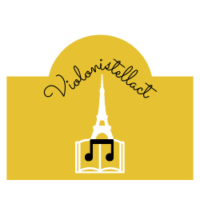Lieber in Verona
To walk in Verona is to follow the rows of walls with two thousand years of history. To lose oneself in Verona is to dare to penetrate its hidden courtyards. To meet oneself in Verona is to accept the keys of the locks, to open doors and windows while undressing your armor…
Veneto is easily reached by train. As in Turin, the station in Verona is called Porta Nuova, and the name tells the life of this place… adored at all costs by those who were born there, cherished by all the foreigners who are welcomed there. My first steps in the city take me to Via Mazzini, which intoxicates me with scents and desires: leather goods, jewelry, and ice-cream, before catching a glimpse, a cloud of glory, Juliet’s House!
I was 8 years old then, I was inspired by the epistolary verses in the open museum book.
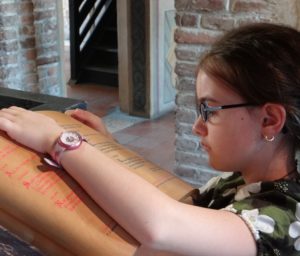
Today, I am the age of Juliet, the heroine of William Shakespeare in his play of abundant passion and caressing obstinacy. I understand why so many people recognize themselves in Juliet and correspond with her first secretary Ettore Solimani.

All these letters pinned behind her bronze statue, it’s magic without borders! Love stories to please… hard to get rid of. Yet each padlock on the wall holds the promise of sincere love, carried by the voice of the one who makes writing real:
« What’s in a name? That which we call a rose
By any other name would smell as sweet.
So Romeo would, were he not Romeo called,
Retain that dear perfection which he owes
Without that title. Romeo, doff thy name,
And for that name, which is no part of thee
Take all myself. »

In its entirety, this is how we must contemplate Verona, the city of lovers… because it is also a city of monuments and good times.
Walking towards the Adige River, a majestic equestrian statue stands in front of me: a horse, paw raised, head lowered; a horseman, called Garibaldi “hero of the two worlds”. The province is hilly, I guess its nature bordered by the wave of waters in the ravines: a farmland of horse fairs. The music catches up with me at a gallop ♪♪ : if I tell you Risorgimento… if I invite you into my thoughts, come… run, run, cross the Piazza delle Erbe and its colorful market: yes, riding enthusiasts, there are saddles! … we sneak under the arcades of the Domus Mercatorum: how beautiful the windows of the merchants are! … passing the Porta Borsari, you touch the Adige on the other side ☺ … and, via Guglielmo Oberdan, we hear the song: Va pensiero!
The orchestra roars in its immense arena, witness of a distant time, and responds to the choir which resonates up to the grid ornated of the emblem, the ladder of the Scaligeri family: a common message climbs its steps and I find there forever the secrets of the sound depths of my Lieber, at the stand of the Italian violins.
Information about Verona
Veneto
Veneto is a region in the north-east of Italy: it is known for the lagoon and canals of Venice in its heart, in the delta of the Po. But the landscape of its farmland is another traditional and natural treasure: the Dolomites and its peaks are a UNESCO World Heritage Site, the Lake Garda looks like a sea embedded between plain and mountains… a monastery in Castelletto reflects the softness of its circular character.
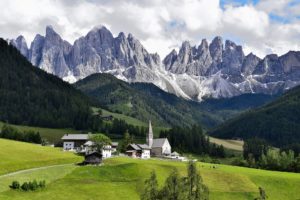
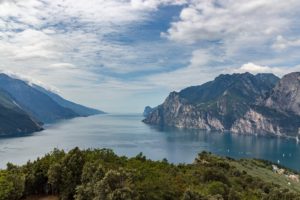
Porta Nuova
Many Italian stations are called Porta Nuova: in Milan (a station that became Porta Garibaldi in November 1961), in Turin, in Verona (still today). The adjective evokes audacity, luxury and dynamism. Verona terminal welcomes 25 million travelers every year.

Via Mazzini
Via Mazzini is Verona’s showcase street: as in other major Italian cities, fashion is privileged. As a pedestrian area, it is obviously very lively!
Historically, it must be represented surrounded by barracks and warehouses in the industrial world of the nineteenth century. Thus, before being paved with marble, it made the scent of mud flows on the occasion of each rain. Named in honor of the Italian politician and philosopher Giuseppe Mazzini (1805-1872) at the beginning of the 20th century, it symbolizes emancipation and freedom.
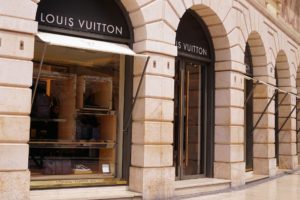
* For luxury boutiques, it’s Corso Santa Anastasia Street ☺
Juliet’s House
Juliet’s famous house is a 13th century Gothic palace. Long owned by the noble family Dal Cappello, it is in the street of the same name that it is built in the heart of the historic center of Verona. The keystone of the inner arch of its courtyard still has the hat-shaped emblem of these wealthy owners.
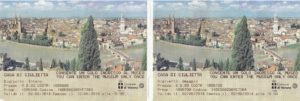
In 1905, the building was transformed into a museum and the medieval house, restored in the mid-1930s, was used for temporary exhibitions. Visitors from all over the world come to project their literary imagination on the bricks of this beautiful facade with three-lobed windows and a balustrade, characteristic of the communication between the exterior courtyard and the interior rooms of the house. In the foreground, the balcony overlooks the place. And in the courtyard is also the bronze statue of Juliet, work of sculptor Nereo Costantini: touching her right breast, which shines, would bring good luck!
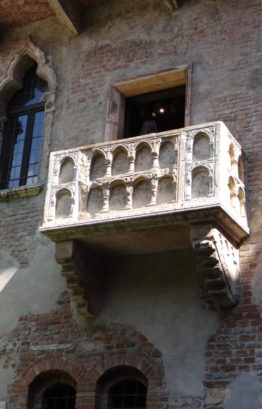
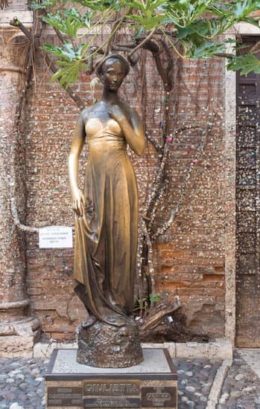

Inside, furniture and costumes from the Renaissance period and an unmade bed materialize the eternal staging elements of the Shakespearean theater.

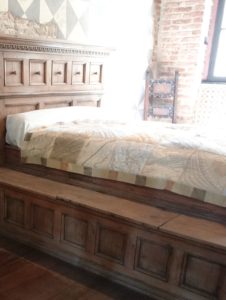

William Shakespeare
William Shakespeare, the famous English author, poet and actor, has produced thirty-seven dramatic works and 154 sonnets in his hand.
He is the third most translated writer after Agatha Christie and Jules Verne… It is no coincidence that English often takes the form of “Shakespeare’s language”!

Romeo and Juliet remains one of his most famous creations. The tragedy is read and played in 5 acts. It has been adapted in various formats: music, operas, cinema, comics, manga… and has inspired many other rewriting artists of which West Side Story is just one example!
In Verona, the first place among the gifts is occupied by the small statuettes of the Shakespearean characters.
Ettore Solimani
Ettore Solimani, guardian of Juliet’s tomb in 1930, began to respond generously to the numerous letters left at the monument. It was then that a group of artists entrusted themselves with the pen from hand to hand out of passion for the legend. On a small private mezzanine, surrounded by a piano, a guitar, and a lot of affection, these friends write up to 60,000 letters a year. Their motto is “love and be loved” and their archives contain over 25 years of love correspondence to Juliet.
Giulio Tamassia testifies: “The Japanese give a lot of details about their environment and their relatives, the Europeans are very pragmatic, the Americans present problems to be solved, and the Latinos are very romantic.” The city of Verona finances the return stamps itself.

The Adige River
The Adige is the longest river in Italy after the Po, it is even joined by the Isarco. Crossing Verona, it places very early the antique Italian city in a course between the Mediterranean Sea, the North Sea, and the Baltic Sea. Experts in river navigation, the Romans connected the Adige to the Po in order to transport the marble, in addition to the floating of wood. The construction of mills (48 floating and 15 fixed around 1570) in the 16th century strengthened the river system for agriculture and industry. Nowadays, the city is less in fusion with its river, because of its excessive exploitation.

Statue of Garibaldi
Located in Piazza Indipendenza, the bronze equestrian statue of Francesco Barzaghi, representing Giuseppe Garibaldi (1807-1882), resides peacefully in a small park not far from the river.

The historical figure is cited as a « hero of the two worlds » in tribute to his expeditions in South America and Europe. Praised by great French writers such as Victor Hugo, Alexandre Dumas, and George Sand, he was also financially assisted in his military works by the United Kingdom and the United States.
Horse Fairs
As Verona is famous for its lovers, it is also nicknamed the city of horses. Important agricultural center with a commercial vocation, horse sales and purchases were already a very important activity before the invention of the automobile.

Fieracavalli is the international horse festival in Verona, founded in 1898. Every year, the most beautiful steeds in the world are presented.
Risorgimento
Was the Risorgimento born with the Italian Enlightenment, with the French Revolution, or with the first revolutions of 1821? In English, it could be translated by resurgence. Effectively, it acts as an intellectual, literary and political renaissance. It is made up of all the events that led to the complete liberation of Italy and the unification of the country under the impetus of Giuseppe Garibaldi, in the 19th century. Its theorist is none other than Giuseppe Mazzini.
![]()

Piazza delle Erbe

The oldest square in Verona, it was home to the forum of the Roman era. The “Madonna Verona” (“Virgin of Verona”) surmounts the fountain and watches over the square, as do the great architectural monuments that surround it; the Maffei Palace, with its baroque style and its six statues of Roman deities, is one of them.
A market is held in the square daily, and restaurants offer local dishes to tourists.
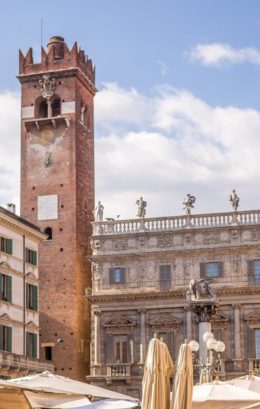

Domus Mercatorum
This medieval house is essential for the influence of Verona: it was home to the corporation of arts and crafts.
 Initially built in wood, it now appears very homogeneous, with its crenellations on the roof, its twin windows, and its two-tone stone arches on the corner facade. The small balcony reminds us of another one…
Initially built in wood, it now appears very homogeneous, with its crenellations on the roof, its twin windows, and its two-tone stone arches on the corner facade. The small balcony reminds us of another one…
Porta Borsari

Among the other gates of the ancient Roman city, Porta Borsari is the main entrance to the fortified town of Verona in the Veneto region.
Made of white limestone, its two arched doors and two rows of windows make it monumental. Commissioned by Emperor Gallieno, it was originally part of a larger structure, Porta Jovia, which was erected in reference to a temple of the god Jupiter. Taxes were collected on import/export goods.
Va pensiero (Nabucco, Giuseppe Verdi)

In 2014, this operatic aria accompanied the artistic performance on ice of the Swiss skater Stéphane Lambiel, in the heart of the Verona arena. In Italy, the significance of this song is both melodic – because it is magnificent – and political – because it is historical. For Giuseppe Verdi, who composed the libretto Nabucco in 1841, Va pensiero is the chorus of the third act, with a beginning in unison, in a rapid succession of intense situations. For the Italian people, in vogue for the Risorgimento, Va pensiero is expected to become the Italian national anthem. It will not be… but it will retain the strength of the bond.
The Verona Arena
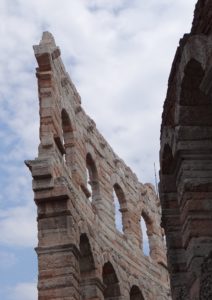

The Verona Arena, the third largest Roman amphitheater, is also surely the best preserved.
Located in Piazza Bra, it hosts numerous events, in tune with the city’s vibes. Many lyric performances can be held there, it’s unique!
The Wind Music Awards (Italian equivalent to the Grammy Awards) are held annually in this magical and historical site. The closing ceremony of the 2026 Winter Olympic Games should also take place in this majestic 22,000-seat arena.


The Scaligeri (Scaliger Tombs)
The Famiglia Scaligera, also known as the Della Scala family, is a dynasty that ruled the city of Verona from 1262 to 1387 (125 years). The Church of Santa Maria Antica in Verona was their chapel, and for this reason it is lined with the tombs of the various members of their family.
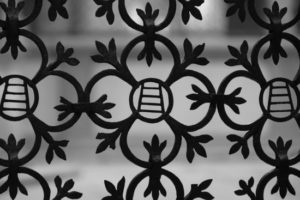
The Gothic mausoleums are encircled by a marble balustrade and decorated with religious scenes. An ornate gate bearing the family emblem, the ladder, surrounds them.
